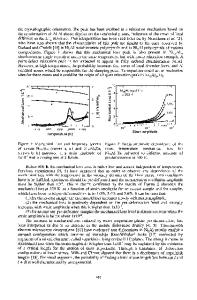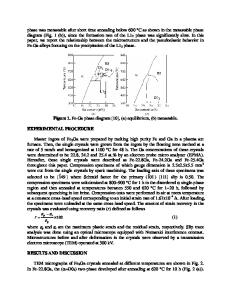Ordered structure formation in the flux-grown Ba(Mg 1/3 Ta 2/3 )O 3 single crystals
- PDF / 659,526 Bytes
- 7 Pages / 612 x 792 pts (letter) Page_size
- 17 Downloads / 333 Views
Chen-Chia Chou Department of Mechanical Engineering, National Taiwan University of Science and Technology, 43 Keelung Road, Section 4, Taipei, 106 Taiwan, Republic of China
Dah-Shyang Tsaia) Department of Chemical Engineering, National Taiwan University of Science and Technology, 43 Keelung Road, Section 4, Taipei, 106 Taiwan, Republic of China (Received 12 October 2000; accepted 12 March 2001)
Formation of ordered structure in flux-grown Ba(Mg1/3Ta2/3)O3(BMT) single crystals was studied using x-ray diffraction, electron diffraction, and high-resolution electron microscopy. The low-temperature-grown crystals exhibited no sign of B-site ordering. Annealing at 1500 °C induced the 1:2 ordered phase, and its content increased with the annealing time. The superlattice diffraction peaks were broad initially; they sharpened rapidly with the annealing time. Diffuse superlattice reflections were found in electron diffraction patterns of 1500 °C annealed BMT; they turned into sharp reflections under long annealing time or higher temperature, 1600 °C. The intensity of diffuse reflections was sparsely distributed, but the maximum intensity location was determined in the digitized recording of image plate. The maximum intensity sites of two diffuse reflections in the 〈111〉 direction deviated from the presumed 1/3 and 2/3 positions and shifted towards the center. The diffuse reflection and the deviation from regular positions were interpreted as the composition modulation during B-site cation diffusion.
I. INTRODUCTION
The ordered structure in complex perovskites, Ba(B1/3Ta2/3)O3, B ⳱ Mg or Zn, plays a critical role in their microwave dielectric properties, which are essential in applications such as resonators or bandpass filters.1–3 Existence of large ordered domains in Ba(Mg1/3Ta2/3)O3 (BMT) ceramics generally warrants a low tangent loss, which is a major feature in its properties. The connection between the B-site ordering and the collective ionic vibrations in electric field has been theoretically studied by Sagala and Nambu.4 The weak coupling between vibration modes of 1:2 ordered structure is interpreted as the root for low tangent loss.5,6 This fundamental connection between low tangent loss and ordering underlies the microstructure research for the ordering formation. Figure 1 illustrates the cation arrangement of BMT 1:2 ordered structure.
a)
Address all correspondence to this author. e-mail: [email protected] J. Mater. Res., Vol. 16, No. 6, Jun 2001
http://journals.cambridge.org
Downloaded: 17 Mar 2015
The mixed oxide method is often used to prepare BMT ceramic specimens. The powder mixture is calcined between 1200 and 1300 °C. After ball milling and press forming, the powder compact is sintered at 1600 or 1650 °C.7–10 Although the parent perovskite structure has been established in calcination, the 1:2 ordering feature in the x-ray diffraction pattern of calcined powder is barely observable.7 After sintering, the 1:2 ordering feature becomes apparent, and a number of ordered domains of size 10–40 nm appe
Data Loading...











